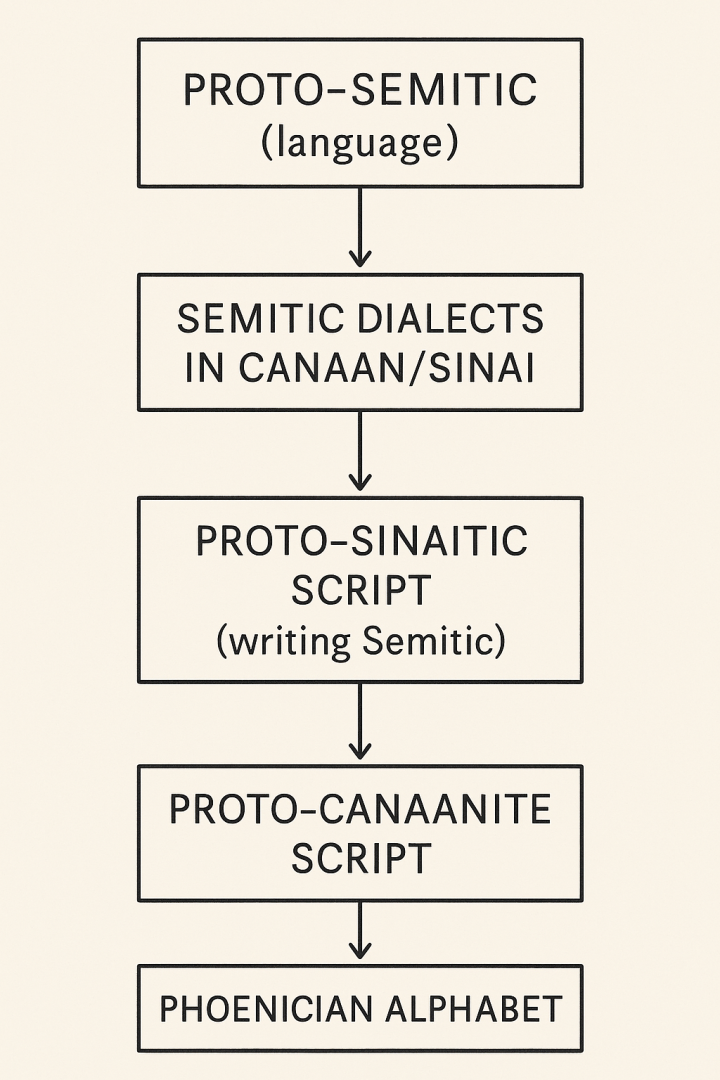Are Proto-Sinaitic script and Proto-Semitic language related? How do they develop into the Phoenician script?
Proto-Sinaitic script and Proto-Semitic language are related, but they are not the same thing—they operate in different linguistic domains:
- Proto-Semitic is a language: the hypothetical reconstructed ancestor of all Semitic languages, such as Hebrew, Arabic, Aramaic, and Akkadian.
- Proto-Sinaitic is a script: an early writing system developed to record language, specifically influenced by Egyptian hieroglyphs and used to write early Semitic languages.
The Connection Between Proto-Sinaitic and Proto-Semitic
- Proto-Sinaitic script (c. 1800–1500 BCE) was likely developed by Semitic-speaking workers or settlers in the Sinai region, who were familiar with Egyptian hieroglyphs.
- These people spoke dialects descended from Proto-Semitic, so the writing system they created was used to represent Semitic sounds.
- Many of the Proto-Sinaitic symbols are acrophonic: a symbol represented a sound based on the first sound of the Semitic word for the pictured item. For example, a drawing of a house (from Semitic bayt) was used for the sound /b/.
Evolution into Phoenician
The development of the Phoenician script from Proto-Sinaitic happened through intermediate stages:
- Proto-Sinaitic (c. 1800–1500 BCE) – early pictographic script, limited in number of inscriptions, used acrophony.
- Proto-Canaanite (c. 1500–1050 BCE) – transitional script, more standardized, used in Canaan (Levant).
- Phoenician (c. 1050 BCE onward) – fully alphabetic, standardized 22-character script that influenced nearly all later alphabets, including Greek and Latin.

How did the Phoenician alphabet eventually evolve into Hebrew? Additionally, when did Hebrew become a fully developed, standardized language?
The Phoenician alphabet evolved into Paleo-Hebrew, the earliest script used to write the Hebrew language, around the 10th century BCE. This development marked a branching within the family of Canaanite scripts, where different Semitic peoples (like the Israelites and Moabites) began using slightly regionalized versions of the script to write their own languages.
From Phoenician to Hebrew Script
- Phoenician Alphabet (c. 1050 BCE):
- Used across the Levant.
- 22 letters, all consonants (an abjad).
- Foundation for many scripts: Aramaic, Greek, Old Italic, and more.
- Paleo-Hebrew Script (10th–6th century BCE):
- A variant of the Phoenician script used by Israelites.
- Used in inscriptions like the Siloam Inscription and Gezer Calendar.
- Not radically different in form Phoenician.
- Aramaic Influence and the Square Script:
- After the Babylonian Exile (6th century BCE), Jews increasingly adopted the Aramaic script, the official script of the Persian Empire.
- Over time, this evolved into the “Jewish square script”, what we now call modern Hebrew script.
- This transition was largely complete by the 3rd century BCE, especially for religious and formal writing.
Formalization of the Hebrew Language
- Spoken Hebrew existed as a dialect of Canaanite since around 1200 BCE.
- Biblical Hebrew was the literary and liturgical form used to write most of the Hebrew Bible (Tanakh), composed roughly between 1000–200 BCE.
- By the 2nd century CE, Hebrew had mostly ceased as a spoken vernacular, replaced by Aramaic and later other languages, but remained in religious, literary, and legal use.
- The Masoretes (c. 600–1000 CE) later formalized Hebrew with vowel markings (niqqud) to preserve pronunciation and scripture.
Summary Timeline
| Date | Development |
|---|---|
| c. 1050 BCE | Phoenician alphabet spreads |
| c. 1000–600 BCE | Paleo-Hebrew used in Israel |
| 586 BCE | Babylonian Exile, rise of Aramaic influence |
| 500–200 BCE | Transition to “square” Aramaic-derived Hebrew script |
| 1000 BCE–200 BCE | Biblical Hebrew flourishes |
| c. 600–1000 CE | Masoretic Hebrew formalized with vocalization system |
Resources
Curated list of reliable resources (books, articles, and online references) that cover the major topics we discussed:
🔤 1. Scripts and Writing Systems
Books:
- “The World’s Writing Systems” — edited by Peter T. Daniels and William Bright
Comprehensive reference covering Proto-Sinaitic, Proto-Canaanite, Phoenician, Hebrew, and more. - “Reading the Past: Ancient Writing from Cuneiform to the Alphabet” by J.T. Hooker
Includes detailed images and explanations of early alphabetic scripts.
Online Resources:
- Ancient Scripts: Semitic
Concise overview of Semitic scripts including Proto-Sinaitic and Proto-Canaanite. - Omniglot: Phoenician & Hebrew Scripts
Charts and info comparing historical scripts.
🗣 2. Languages and Etymology
Books:
- “The Semitic Languages” by Robert Hetzron
Covers the Proto-Semitic language and its descendants. - “A History of the Hebrew Language” by Angel Sáenz-Badillos
Excellent overview from Proto-Semitic to modern Hebrew.
Articles:
- “The Origin of the Hebrew Language” — The Jewish Virtual Library
- “Ivri and Hebrew: What’s in a Name?” — My Jewish Learning
📜 3. Historical and Biblical Context
Books:
- “Who Wrote the Bible?” by Richard Elliott Friedman
Explores the composition and authorship of the Torah. - “The Bible Unearthed” by Israel Finkelstein and Neil Asher Silberman
Archaeology and historical perspective on early Israel and Moses.
Online:
- Torah and Egyptian Hieroglyphs? – Biblical Archaeology Society
- The Masoretic Text – Jewish Encyclopedia

Leave a Reply